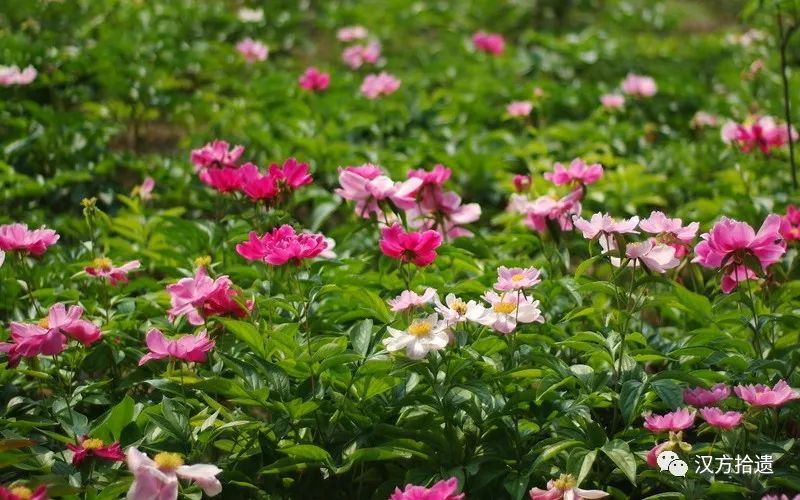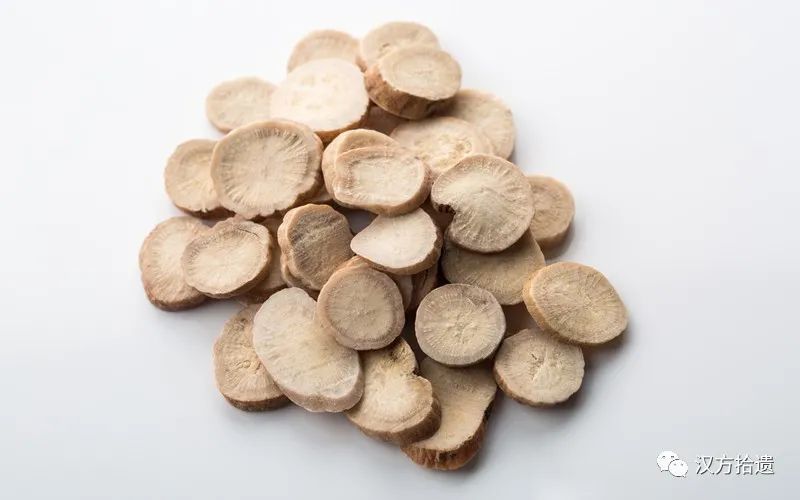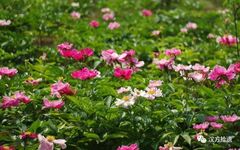“Bai Shao, the name of the herb. Also known as: Bai Shao Yao, Jin Shao Yao. It is the root of the plant Paeonia lactiflora Pall. from the family Paeoniaceae. It has the effects of nourishing blood, astringing yin, softening the liver, alleviating pain, and calming liver yang. It is primarily used for liver blood deficiency, irregular menstruation, disharmony between liver and spleen, pain in the chest, flanks, and abdomen, spasms and pain in the limbs, hyperactive liver yang, headaches, and dizziness.
Properties and Channels
Bitter, sour; slightly cold; enters the liver and spleen channels.

01
—
Functions and Actions
Functions
Nourishes blood, astringes yin, softens the liver, alleviates pain, and calms liver yang.
Indications
1. Liver blood deficiency, irregular menstruation: This herb is sour and astringent, which helps to nourish blood by astringing liver yin. It is often used in combination with Shu Di (Rehmannia), Dang Gui (Angelica), etc., to treat liver blood deficiency, pale complexion, dizziness, palpitations, or irregular menstruation, and excessive bleeding.
2. Disharmony between liver and spleen, pain in the chest, flanks, and abdomen, spasms and pain in the limbs: This herb astringes liver yin, nourishes blood, softens the liver, and alleviates pain. It is commonly paired with Chai Hu (Bupleurum), Dang Gui, Bai Shao, etc., to treat blood deficiency and liver stagnation, and flank pain. It can also treat spleen deficiency with hyperactive liver, abdominal pain, diarrhea, dysentery, and abdominal pain due to yin blood deficiency leading to spasms and pain in the limbs.
3. Hyperactive liver yang, headaches, and dizziness: This herb nourishes blood, astringes yin, and calms liver yang.
4. This herb astringes yin and has the function of stopping sweating. If there is an external invasion of wind-cold, with sweating due to disharmony between the nutritive and defensive qi, it can astringe yin and harmonize the nutritive and defensive qi, used with Gui Zhi (Cinnamon Twig) to warm the channels and promote yang. For yin deficiency with night sweats, it should be used with Long Gu (Dragon Bone), Mu Li (Oyster Shell), and Xiao Mai (Wheat) to achieve the effect of astringing yin and stopping sweating.
5. In Western medicine, it is indicated for anemia due to liver blood deficiency, functional uterine bleeding, chronic nephritis, hypertension, diabetes, hyperthyroidism, central retinal inflammation, and menopausal syndrome due to blood deficiency and hyperactive liver, as well as pulmonary tuberculosis and renal tuberculosis due to insufficient yin blood.
Dosage and Administration
Internal use: decoction, 5-12g; or in pills or powders. Large doses can be used at 15-30g. For calming liver yang, it is used raw; for nourishing and softening the liver, it is stir-fried.
Adverse Reactions
1. Reports indicate occasional discomfort in the upper abdomen and abdominal pain.
2. Allergic reactions: fever, scarlet fever-like or measles-like drug rashes.
Contraindications
1. Contraindications in herbal combinations: avoid Mang Xiao (Glauber’s Salt), Shi Hu (Dendrobium), avoid Bie Jia (Soft-shelled Turtle), Xiao Ji (Cirsium), and counteract Li Lu (Veratrum).
2. Contraindications in combinations with Western medicine:
(1) Should not be used with antihypertensive drugs to prevent orthostatic hypotension.
(2) Should not be used with cardiac glycosides, as it may enhance toxicity.
(3) Combined with heparin, warfarin, aspirin, etc., may increase bleeding tendency.
(4) Theophylline can weaken the inhibitory effect of Bai Shao on intestinal contractions, so they should not be used together.
Precautions
1. Bai Shao is a cold herb; it should not be used in large amounts for those with external wind-cold, internal injury from cold, spleen and stomach deficiency with cold, or kidney yang deficiency. Women with irregular menstruation due to deficiency and cold should not use it in large amounts; those with qi deficiency and spontaneous sweating, or yang deficiency with sweating should avoid it.
2. Bai Shao is sour and cold, and should not be used in cases of yang blockage in the upper jiao or rashes.
3. Bai Shao has a central nervous system inhibitory effect; it should not be used in comatose patients; infants and the elderly should not use it in large amounts for long periods.
4. Pregnant women should not use it in large amounts postpartum.
Chemical Composition
Bai Shao contains paeoniflorin, paeonol, and also contains paeonolide, benzoic acid, etc. Additionally, it contains volatile oil, fatty oil, resin, starch, mucilage, protein, and triterpenoid components.
Pharmacological Effects
1. Effects on the central nervous system: Paeoniflorin has strong sedative, anticonvulsant, and antipyretic effects. Total glycosides of Bai Shao (TGP) have a dose-dependent analgesic effect.
2. Effects on smooth muscle: Paeoniflorin inhibits the smooth muscle of the gastrointestinal tract and uterus, and antagonizes contractions induced by oxytocin.
3. Antimicrobial effects: The decoction of Bai Shao has an inhibitory effect on Shigella dysenteriae. It can also inhibit Staphylococcus, Pseudomonas aeruginosa, pyogenic cocci, pathogenic bacteria of the digestive tract, and opportunistic pathogens. The tincture also has inhibitory effects on certain pathogenic fungi. Total glycosides of Bai Shao (TGP) have antiviral effects.
4. Effects on the immune system: Total glycosides of Bai Shao have a functionally dependent bidirectional regulatory effect on cellular and humoral immune responses.
5. Effects on the cardiovascular system: Paeoniflorin and extracts of Bai Shao can slow heart rate and lower blood pressure, while total glycosides of Bai Shao can raise blood pressure, primarily diastolic, indicating a bidirectional regulation of blood pressure. Paeoniflorin and water extracts of Bai Shao have anti-myocardial ischemia effects.
6. Effects on the blood system: Bai Shao and total glycosides of Bai Shao, as well as benzoyl paeoniflorin, have an inhibitory effect on platelet aggregation.
7. Effects on the digestive system: Bai Shao inhibits the excitability of the parasympathetic nervous system, thus having an antispasmodic effect; it also has a significant inhibitory effect on digestive tract ulcers. It also has a liver-protective effect.
8. Anti-inflammatory effects: Total glycosides of Bai Shao have significant preventive and therapeutic effects on multiple arthritis.
9. Additionally, Bai Shao has effects of lowering blood sugar, enhancing learning and memory functions, relieving cough, scavenging free radicals, antioxidant effects, and anti-hypoxia effects.
Toxicological Effects
1. Acute toxicity experiments: The methanol extract of Bai Shao at 6g/kg intraperitoneally injected into rats and mice resulted in spontaneous movement inhibition, piloerection, diarrhea, and respiratory depression, with 50% mortality in rats and all mice dying within 2 days. No abnormalities were observed with oral administration. The LD50 of paeoniflorin in mice via intravenous injection is 3.53g/kg, and 9.53g/kg via intraperitoneal injection, with no deaths observed with oral administration. The LD50 of total glycosides of Bai Shao in mice and rats via intraperitoneal injection is 125mg/kg and 301mg/kg, respectively. Other reports indicate the LD50 for intravenous and intraperitoneal injection in mice is 159mg/kg and 230mg/kg, respectively, with no significant toxic symptoms or deaths at doses >2500mg/kg orally.
2. Subacute toxicity experiments: Rats were given a daily oral dose of methanol extract of Bai Shao at 1.5g/kg and 3.0g/kg for 21 days. In the low-dose group, an increase in urinary protein was observed. In the high-dose group, significant weight loss, and a marked decrease in red blood cells, hemoglobin, and hematocrit were noted, with a significant increase in mean corpuscular volume and red blood cell distribution width, suggesting possible megaloblastic anemia. Both dosage groups showed splenic enlargement, which was dose-related, with splenic sinus dilation and congestion. Lung weight also significantly increased.
Related Discussions
1. “Shennong Bencao Jing”: “Mainly treats abdominal pain due to evil qi, … stops pain, benefits urination, and boosts qi.”
2. “Bencao Qiuzhen”: “Chi Shao and Bai Shao have similar indications, but Bai Shao has the power to astringe yin and benefit the nutritive qi, while Chi Shao disperses evil and promotes blood circulation; Bai Shao can drain wood from the earth, while Chi Shao can activate stagnation in the blood.”
02
—
Clinical Applications
Clinical Applications
1. Used for irregular menstruation and excessive bleeding: Bai Shao is often combined with Dang Gui, Chuan Xiong, and Shu Di to nourish blood and regulate menstruation, as in the Si Wu Decoction from “Taiping Huimin Heji Ju Fang”. For blood collapse, stopping bleeding is urgent, as in the combination of Bai Shao and He Ye in “Jiyin Gangmu”, which astringes yin, clears the liver, and cools the blood to stop bleeding. Bai Shao can also be combined with Bai Ye to achieve the function of astringing the liver and cooling the blood to stop bleeding.
2. Used for external wind-cold with spontaneous sweating: Bai Shao benefits yin and harmonizes the nutritive qi, combined with Gui Zhi to release the exterior and induce sweating, achieving the function of harmonizing the nutritive and defensive qi, as in the Gui Zhi Decoction from “Shang Han Lun”.
3. Used for pain in the flanks, abdominal pain, and spasms in the limbs caused by liver stagnation and blood deficiency: Bai Shao has the function of softening the liver, alleviating urgency, and stopping pain. For flank pain, it is often combined with Dang Gui, Bai Zhu, and Chai Hu, as in the Xiao Yao San; for postpartum abdominal pain, with Zhi Shi, as in the Zhi Shi Bai Shao San from “Jin Kui Yao Lue”; for treating women’s dysmenorrhea, as in the Dang Gui Bai Shao San; if there is disharmony between liver and spleen causing abdominal spasms and pain, and blood deficiency leading to spasms and pain in the limbs, it is often combined with Gan Cao for a synergistic effect, as in the Bai Shao Gan Cao Decoction from “Shang Han Lun”. If there is cold, cinnamon can be added; if there is heat, Huang Qin can be added. Bai Shao also treats abdominal pain and diarrhea due to hyperactive liver and spleen deficiency, as in the treatment of diarrhea in “Dan Xi Xin Fa”, using Bai Shao with Bai Zhu, Chen Pi, and Fang Feng to soften the liver and alleviate pain; if there is heat causing abdominal pain, it can be used with Huang Qin, as in the Huang Qin Decoction from “Shang Han Lun”.
4. Used for hyperactive liver yang, headaches, and dizziness: Bai Shao nourishes yin and calms the liver, often combined with Sheng Di, Niu Xi, and Dai Zhi Shi, as in the Jian Ling Decoction from “Yi Xue Zhong Zhong Can Xi Lu”; for heat accumulation not dispersing, with red, swollen eyes, or visual obstructions, it is often used with Chai Hu, Jue Ming Zi, and Qing Sang Zi.
Related Combinations
1. Bai Shao combined with Wu Yao: Bai Shao excels at nourishing blood and softening the liver, alleviating urgency and stopping pain; Wu Yao is good at moving qi and stopping pain, warming the kidney and dispersing cold. The combination enhances the effects of nourishing blood, moving qi, and dispersing cold to stop pain, suitable for qi and blood stagnation, and abdominal pain.
2. Bai Shao combined with Gui Jia: Bai Shao excels at astringing yin and draining heat; Gui Jia is good at nourishing yin and subduing yang. The combination enhances the effects of astringing yin and subduing yang, softening the liver, and calming wind, suitable for liver and kidney deficiency, hyperactive liver yang causing dizziness and headaches, and heat diseases injuring fluids, with internal wind causing spasms in the hands and feet.
3. Bai Shao combined with Shi Jue Ming: Bai Shao excels at nourishing blood and softening the liver; Shi Jue Ming is good at calming the liver and subduing yang. The combination has a calming effect on the liver. It is suitable for yin deficiency with insufficient blood, hyperactive yang, and spasms.
4. Bai Shao combined with Mu Xiang: Bai Shao excels at harmonizing blood and stopping pain; Mu Xiang is good at moving qi and stopping pain. The combination enhances the effects of moving qi and harmonizing blood, alleviating urgency and stopping pain, suitable for abdominal pain and diarrhea due to qi stagnation.
5. Bai Shao combined with Fu Zi: Bai Shao excels at nourishing blood and softening the liver, alleviating urgency and stopping pain; Fu Zi is good at warming the kidney and strengthening yang, dispersing cold and stopping pain. The combination enhances the effects of nourishing blood, softening the liver, dispersing cold, and stopping pain, suitable for evil lurking in the lower jiao, diarrhea, abdominal pain like dysentery, excessive sweating, cold limbs, red tongue with white coating, and wiry rapid pulse.
6. Bai Shao combined with Sheng Jiang: Bai Shao excels at nourishing blood and softening the liver; Sheng Jiang is good at warming the stomach and dispersing cold. The combination enhances the effects of nourishing blood and dispersing cold, suitable for blood deficiency with cold, abdominal pain during menstruation, or postpartum abdominal pain.
7. Bai Shao combined with Gou Teng: Bai Shao excels at nourishing blood and softening the liver; Gou Teng is good at nourishing yin and subduing yang. The combination enhances the effects of nourishing yin and subduing yang, nourishing blood, and softening the liver, suitable for headaches, dizziness, irritability, insomnia, and vivid dreams due to insufficient liver blood and hyperactive liver yang.
8. Bai Shao combined with Goji Berries: Bai Shao excels at nourishing blood and softening the liver, alleviating urgency and stopping pain; Goji Berries are good at nourishing the kidney and benefiting essence, nourishing the liver and brightening the eyes. The combination enhances the effects of nourishing blood, softening the liver, and benefiting the kidney, suitable for dizziness, dry mouth, palpitations, and insomnia.
Distinguishing Medicinal Use
1. Raw Bai Shao, fried Bai Shao, wine-fried Bai Shao, vinegar-fried Bai Shao, and earth-fried Bai Shao: There are many ancient processing methods for Bai Shao, but the main processed products still in use today are raw Bai Shao, fried Bai Shao, wine-fried Bai Shao, vinegar-fried Bai Shao, and earth-fried Bai Shao.
(1) Raw Bai Shao excels at nourishing blood, astringing yin, and calming liver yang, used for blood deficiency, irregular menstruation, dysmenorrhea, excessive bleeding, headaches, dizziness, tinnitus, irritability, and spontaneous sweating.
(2) Fried Bai Shao has a slightly milder nature, primarily nourishing blood and astringing yin, used for abdominal pain and diarrhea due to hyperactive liver and spleen deficiency, or prolonged diarrhea with abdominal pain that prefers pressure and warmth.
(3) Wine-fried Bai Shao has reduced sour and cold properties, good for harmonizing the middle and alleviating urgency, stopping pain, used for flank pain, abdominal pain, and postpartum abdominal pain. Vinegar-fried Bai Shao primarily enters the liver and excels at astringing, with functions of astringing blood, stopping bleeding, and soothing the liver to relieve stagnation.
(4) Earth-fried Bai Shao can borrow the earth’s qi to enter the spleen, enhancing the effects of softening the liver and spleen, and stopping diarrhea, primarily treating diarrhea due to hyperactive liver and spleen deficiency, or prolonged diarrhea with a preference for warmth and pressure.
2. Chi Shao and Bai Shao: Chi Shao and Bai Shao are two types of the same category, historically used interchangeably, but differentiated in the Song and Yuan dynasties. Although both are slightly cold in nature, their effects are quite different. Chi Shao is bitter and enters the liver channel, being a cooling and dispersing herb, effective in clearing heat, cooling blood, and resolving stasis to stop pain, especially suitable for blood heat and blood stasis. It is effective in treating liver fire attacking the eyes, red and swollen eyes, and liver stagnation causing flank pain, as well as heat entering the nutritive blood, blood heat rashes, vomiting blood, blood stasis causing amenorrhea, dysmenorrhea, and traumatic injuries. Bai Shao is sour and bitter, entering the liver and spleen channels, being a blood-nourishing and yin-aiding herb, effective in nourishing blood, regulating menstruation, astringing yin to stop sweating, and calming the liver to relieve pain, especially suitable for yin blood deficiency and hyperactive liver. It is effective in treating blood deficiency with hyperactive liver causing dizziness, flank pain due to liver stagnation, and blood deficiency leading to irregular menstruation and dysmenorrhea, as well as night sweats due to yin deficiency.
3. Dang Gui and Bai Shao: Both can nourish blood, regulate menstruation, and stop pain, commonly used for irregular menstruation and blood deficiency. However, Dang Gui is warm in nature, suitable for blood deficiency with cold; Bai Shao is slightly cold, suitable for blood deficiency with heat. Dang Gui nourishes blood, invigorates blood circulation, and alleviates pain, used for blood deficiency with blood stasis and cold; Bai Shao astringes yin, calms the liver, and alleviates pain, best used for pain due to liver stagnation and blood deficiency. Additionally, Dang Gui treats blood deficiency causing numbness and pain, traumatic swelling, and can also moisten the intestines and relieve constipation. Bai Shao also treats dizziness due to blood deficiency and can stop sweating, treating spontaneous sweating and night sweats.
4. Shi Jue Ming and Bai Shao: Both herbs enter the liver channel and have the effect of calming the liver and subduing yang, used for headaches and dizziness caused by liver and kidney yin deficiency and hyperactive liver yang. However, Shi Jue Ming is salty and cold, entering the liver channel, and can clear liver fire, nourish liver yin, and has the effect of brightening the eyes and dispelling visual obstructions, making it a key herb for treating eye diseases, suitable for both deficiency and excess conditions. Bai Shao is sweet and nourishing, with the effects of nourishing blood, astringing yin, regulating menstruation, and stopping pain, suitable for treating pale complexion due to liver and spleen blood deficiency, dizziness, palpitations, and fatigue, as well as irregular menstruation, excessive bleeding, and abdominal pain during menstruation. Bai Shao also nourishes liver blood, astringes liver yin, nourishes blood, softens the liver, and alleviates pain, treating blood deficiency with hyperactive liver, qi stagnation causing flank pain, disharmony between liver and spleen causing abdominal spasms, or liver blood deficiency leading to spasms and pain in the limbs, as well as spleen deficiency with liver excess causing abdominal pain and diarrhea, and dysentery with blood and urgency.
Related Medicinal Products
Fu Kang Ning Tablets, Gui Shao Di Huang Pills, Modified Xiao Yao Pills, Si Ni San, Xin Ketong Capsules, Wei Shu Ning Granules, Menopausal Heart Capsules.
Related Formulas
Bai Shao Gan Cao Decoction (from “Shang Han Lun”), Xiao Jian Zhong Decoction (from “Shang Han Lun”), Bai Shao Decoction (from “Bei Ji Qian Jin Yao Fang”), Bai Shao Decoction (from “Suwen: Bing Ji Qi Yi Bao Ming Ji”), Bai Shao Huang Qi Decoction (from “Chi Shui Xuan Zhu”), Dang Gui Bai Shao San (from “Jin Kui Yao Lue”).
Dietary Therapy
Bai Shao and Chuan Xiong Stewed Fish Head:
1. Efficacy: Moves qi, nourishes blood, calms pain, nourishes yin, benefits the kidney, strengthens the body, suitable for patients with intercostal neuralgia.
2. Ingredients: Bai Shao 10g, Chuan Xiong 10g, Gan Cao 6g, carp head 1 (500g), cooking wine 20g, ginger 10g, scallions 15g, salt 4g.
3. Method: Soak Bai Shao, Gan Cao, and Chuan Xiong, slice them; clean the carp head, remove the gills, slice the ginger, and cut the scallions. Rub the fish head with cooking wine and salt, place it in a stewing pot, add Bai Shao, Gan Cao, and Chuan Xiong, pour in 800ml of water, and add ginger and scallions. Place the pot on high heat until boiling, then simmer on low heat for 20 minutes.
4. Usage: Once daily. Each serving of fish head is 50-100g.
Note
Pharmacokinetics:
1. After oral administration of Bai Shao in rats, paeoniflorin, paeonolide, gallic acid, etc., can be detected in plasma, with the highest content of paeoniflorin, its bioavailability being 3.12%, Tmax being 102 minutes, and Cmax being 9.93mg/L. After intravenous injection of paeoniflorin in rats, the blood concentration-time curve fits a two-compartment model, with pharmacokinetic parameters of t1/2α being 2.6 minutes and t1/2β being 27.4 minutes.
2. Paeoniflorin and paeonolide can be detected in various tissues, with higher concentrations in the small intestine, stomach, large intestine, kidney, spleen, and liver, easily accumulating in the gastrointestinal tract; after intravenous injection, paeoniflorin rapidly appears in urine in its original form, with cumulative excretion in urine being 36.85% and 79.33% in the first 20 minutes and 7 hours, respectively, and cumulative excretion in bile being 3.77% of the injected amount after 7 hours.

03
—
Processing and Preparation
Harvesting and Processing
Harvest in summer and autumn, clean off soil and rootlets, peel, soak in boiling water or slightly boil until evenly heated, and dry in the sun. When using, soak and slice. Generally used raw or stir-fried with wine or dry-fried.
Preparation Methods
1. Bai Shao: Clean, soak, slice thinly, and dry.
2. Fried Bai Shao: Take clean Bai Shao slices and stir-fry until slightly yellow.
3. Wine-fried Bai Shao: Take clean Bai Shao slices and stir-fry with wine until slightly yellow.
Storage Methods
Store in a ventilated and dry place to prevent pests; wine-fried Bai Shao and vinegar-fried Bai Shao should be sealed.
04
—
Identification of Medicinal Materials
Identification
1. The powder of this product is yellowish-white. There are many gelatinized starch granules. Calcium oxalate clusters range from 11-35μm in diameter, found in parenchyma cells, often arranged in rows, or a single cell may contain several clusters. It has bordered pit vessels and reticulate vessels with diameters of 20-65μm. Fibers are long and spindle-shaped, with diameters of 15-40μm, thick-walled, slightly lignified, with large round pits.
2. Take 0.5g of this product powder, add 10ml of ethanol, shake for 5 minutes, filter, evaporate the filtrate, and dissolve the residue in 1ml of ethanol to prepare the test solution. Also, take a reference sample of paeoniflorin, prepare a solution containing 1mg per 1ml in ethanol as a control solution. Perform thin-layer chromatography (TLC) test, applying 10μl of each solution on the same silica gel G plate, using chloroform-ethyl acetate-methanol-formic acid (40:5:10:0.2) as the developing agent, develop, remove, dry, spray with 5% vanillin-sulfuric acid solution, and heat until the spots are clearly visible. The test solution should show the same blue-purple spots at the corresponding positions as the control solution.
Characteristics of Medicinal Materials
This product is cylindrical, straight or slightly curved, with flat ends, 5-18cm long and 1-2.5cm in diameter. The surface is whitish or light brownish-red, smooth or with longitudinal wrinkles and fine root marks, occasionally with remnants of brownish outer skin. The texture is solid, not easily broken, with a relatively flat cross-section, whitish or slightly brownish-red, with distinct growth rings and radiating rays. It has a slight odor and a slightly bitter, sour taste.
Characteristics of Slices
1. Bai Shao: This product appears as round thin slices. The surface is light brownish or whitish, smooth. The cut surface is whitish or slightly brownish, with distinct growth rings, and slightly raised vascular markings arranged radially. It has a slight odor and a slightly bitter, sour taste.
2. Fried Bai Shao: This product resembles Bai Shao slices, with a slightly yellow or light brownish-yellow surface, some may have scorch marks. It has a slight fragrance.
3. Wine-fried Bai Shao: This product resembles Bai Shao slices, with a slightly yellow or light brownish-yellow surface, some may have scorch marks. It has a slight wine aroma.
05
—
Botanical Information
Plant Species
Plant of the family Paeoniaceae, genus Paeonia.
Morphological Characteristics
Perennial herb, 40-70cm tall, hairless. The root is thick, spindle-shaped or cylindrical, dark brown. The stem is erect, branched at the top, with several membranous sheath-like scales at the base. Leaves are alternate; petioles can be up to 9cm long, with shorter petioles at the top of the stem; the lower leaves are twice pinnate, while the upper leaves are thrice pinnate; leaflets are narrow-ovate, elliptical, or lanceolate, 7.5-12cm long and 2-4cm wide, with a gradually pointed tip, wedge-shaped or oblique base, and white cartilaginous serrations on the edges, hairless on both sides, with sparse short soft hairs along the leaf veins on the underside, nearly leathery. Flowers are bisexual, several bloom at the top of the stem and in leaf axils, with a diameter of 7-12cm; bracts are 4-5, lanceolate, of unequal size; sepals are 4, broadly ovate or nearly round, 1-1.5cm long and 1-1.7cm wide, green, persistent; petals are 9-13, obovate, 3.5-6cm long and 1.5-4.5cm wide, white, sometimes with deep purple spots or pink at the base, cultivated varieties have petals of various colors and double petals; there are many stamens, with filaments 7-12mm long, and yellow anthers; the flower disc is shallowly cup-shaped, enveloping the base of the carpels, with blunt and rounded lobes at the tips; carpels are 2-5, free, hairless. The achene is oval or oval-shaped, 2.5-3cm long and 1.2-1.5cm in diameter, with a beak at the tip. Flowering period is May to June, fruiting period is June to August.
Distribution Area
Distributed in Northeast China, North China, Shaanxi, and Gansu. Cultivated in many cities and towns.
Production Areas
Mainly produced in Zhejiang, Anhui, Sichuan, and other regions.
Growth Environment
Grows in grassy slopes and under forests.
Growth Habits
Prefers warm and humid climates, is cold-resistant, drought-resistant, and sensitive to waterlogging. It is best cultivated in sunny, deep, well-drained, fertile, loose soil rich in humus or sandy loam. Saline-alkaline and waterlogged soils are not suitable for planting. It should not be planted continuously and can be rotated with safflower, chrysanthemum, and leguminous crops.
Propagation Methods
Propagated by seeds or by dividing roots.
Cultivation Techniques
1. Seed propagation: Sow in late September, open furrows on prepared beds, sow seeds evenly in 3cm deep furrows, cover with 6-10cm of soil, and compact. The weight of 1000 seeds is 161.2g, with a sowing amount of 52.5-60kg per hectare. In April of the following year, remove some of the covering soil, and seedlings can emerge in about half a month.
2. Root division propagation: Cut the root at 3-4cm below the base of the bud, split with a knife, dividing each clump into 3-5 plants, ensuring each has 1-2 buds, and plant at a spacing of (60-90)cm × 45cm, with 1-2 plants per hole, covering the soil tightly and watering to cultivate through winter. About 30,000 plants can be planted per hectare. To increase yield, apply appropriate amounts of organic fertilizer.
Pest and Disease Control
1. Diseases include brown spot disease, damping-off disease, root rot, gray mold disease, and rust disease, which can be controlled by spraying carbendazim, mancozeb, or digging up and burning the entire plant.
2. Pests include red spider mites, aphids, grubs, and cutworms.


· Han Fang Shi Yi ·

Long press to identify the QR code to follow
For inquiries about medicinal materials, promoting traditional Chinese medicine, welcome to subscribe for free!
▶丨About Us
Han Fang Shi Yi (zycorgcn) is a brand of Traditional Chinese Medicine Network (zyc.org.cn) linked platform. Founded by Zhongzhai Media, it provides free inquiries about medicinal materials, shares classic works of traditional Chinese medicine, health culture, and information on the development of traditional Chinese medicine, promoting the essence of Chinese traditional medicine.Welcome to subscribe for free!
▶丨Copyright Statement
The copyright of the above text and images belongs to Han Fang Shi Yi (WeChat ID: zycorgcn), and reprinting must retain this copyright statement.

